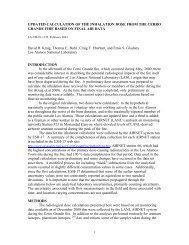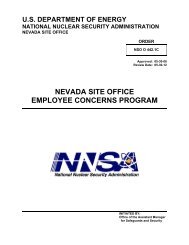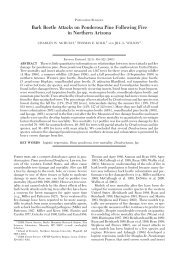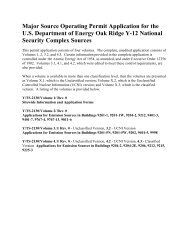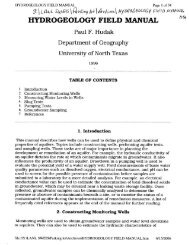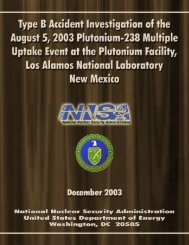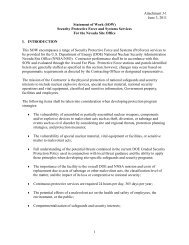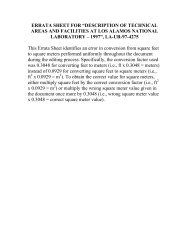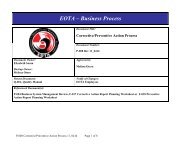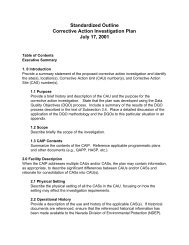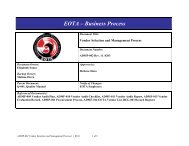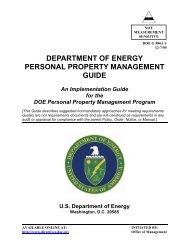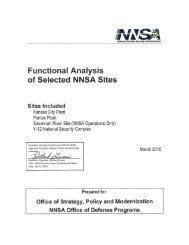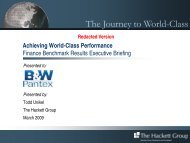131 LA UR 03 5862 - National Nuclear Security Administration ...
131 LA UR 03 5862 - National Nuclear Security Administration ...
131 LA UR 03 5862 - National Nuclear Security Administration ...
- No tags were found...
You also want an ePaper? Increase the reach of your titles
YUMPU automatically turns print PDFs into web optimized ePapers that Google loves.
In addition, the Key Facilities (as presented in the SWEIS) comprised 42 of the 48 Category 2 andCategory 3 <strong>Nuclear</strong> Structures at <strong>LA</strong>NL. 1 Subsequently, DOE and <strong>LA</strong>NL have published five lists identifyingnuclear facilities at <strong>LA</strong>NL [one in 1998 (DOE 1998a), another in 2000 (DOE 2000a), two in 2001 (<strong>LA</strong>NL2001a, b), and one in 2002 (<strong>LA</strong>NL 2002a)] that significantly changed the classification of some buildings.<strong>Nuclear</strong> and Radiological Facility DesignationsTable 2.0-10 shows the nuclear facilities identified in the SWEIS and those identified in 2002 (<strong>LA</strong>NL2002a). Appendix B provides a summary of the nuclear facilities and a table has been added to each sectionof this chapter to explain the differences and identify the 23 structures currently listed by DOE as nuclearfacilities. Of these 23 structures, all reside within a Key Facility. The only Non-Key Facility listed in2001 was the former tritium research facility (TA-33-86), but the facility underwent decontamination anddecommissioning in 2002, was demolished, and was removed from the nuclear facility list. Appendix Cprovides a comparison of the facilities identified as radiological when the SWEIS was prepared and thoseidentified as radiological in 2001 and 2002 (<strong>LA</strong>NL 2001c, 2002b). The 2001 and 2002 lists are shorter due tobetter guidance on the radiological designation. 2Definition of Key FacilitiesThe definition of each Key Facility hinges upon operations 3 , capabilities, and location and is notnecessarily confined to a single structure, building, or technical area. In fact, the number of structurescomprising a Key Facility ranges from one, the MSL, to more than 400 for <strong>LA</strong>NSCE. Key Facilities can alsoexist in more than a single technical area, as is the case with the High Explosives Testing and High ExplosivesProcessing Key Facilities, which exist in all or parts of five and seven technical areas, respectively.This chapter discusses each of the 15 Key Facilities from three aspects—significant facility constructionand modifications, types and levels of operations, and operations data by calendar year from the publication ofthe SWEIS through 2002. Each of these three aspects is given perspective by comparing them to projectionsmade by the SWEIS ROD. This comparison provides an evaluation of whether or not data resulting from<strong>LA</strong>NL operations continue to fall within the environmental envelope established by the SWEIS ROD.It should be noted that construction activities projected by the SWEIS ROD were for the 10-year period1996–2005. All construction activities will not be complete and projected operations may not reach maximumlevels until the end of the 10-year period. Table 2.0-11 identifies the construction and modifications projectedby the SWEIS ROD and what activity has occurred from 1998-2002. Table 2.0-12 summarizes the projectedconstruction and modifications that have been completed. Table 2.0-13 summarizes the usage of capabilitiesby facility while Table 2.0-14 concentrates on those capabilities that have been inactive or lost. Table 2.0-15provides an overview of emissions and solid waste while Table 2.0-16 summarizes flow from the permittedoutfalls.1 DOE Order 5480.23 (DOE 1992a) categorizes nuclear hazards as Category 1, Category 2, or Category 3. Because <strong>LA</strong>NL has no Category 1 nuclearfacilities (usually applied to nuclear reactors), definitions are presented for only Categories 2 and 3:• Category 2 <strong>Nuclear</strong> Hazard–has the potential for significant onsite consequences. DOE-STD-1027-92 (DOE 1992b) provides the resulting thresholdquantities for radioactive materials that define Category 2 facilities.• Category 3 <strong>Nuclear</strong> Hazard–has the potential for only significant localized consequences. Category 3 is designed to capture those facilities such aslaboratory operations, LLW handling operations, and research operations that possess less than Category 2 quantities of material. DOE-STD-1027-92(DOE 1992b) provides the Category 3 thresholds for radionuclides.The identification of nuclear facilities is based upon the official list maintained by DOE Los Alamos Site Office as of December 2002 (<strong>LA</strong>NL 2002a).2 Since the publication of the SWEIS, only two radiological facility lists have been published. The first (<strong>LA</strong>NL 2001c) was published in 2001 and thesecond (<strong>LA</strong>NL 2002b) in 2002.3 As used in the SWEIS and this Yearbook, facility operations include three categories of activities—research, production, and services to other <strong>LA</strong>NLorganizations. Research is both theoretical and applied. Examples include modeling (e.g., atmospheric weather patterns) to subatomic investigations(e.g., using the <strong>LA</strong>NSCE linear accelerator [linac]) to collaborative efforts with industry (e.g., fuel cells for automobiles). Production involves deliveryof a product to a customer, such as radioisotopes to hospitals and the medical industry. Examples of services provided to other <strong>LA</strong>NL facilities includeutilities and infrastructure support, analysis of samples, environmental surveys, and waste management.2-10SWEIS Yearbook—2002




